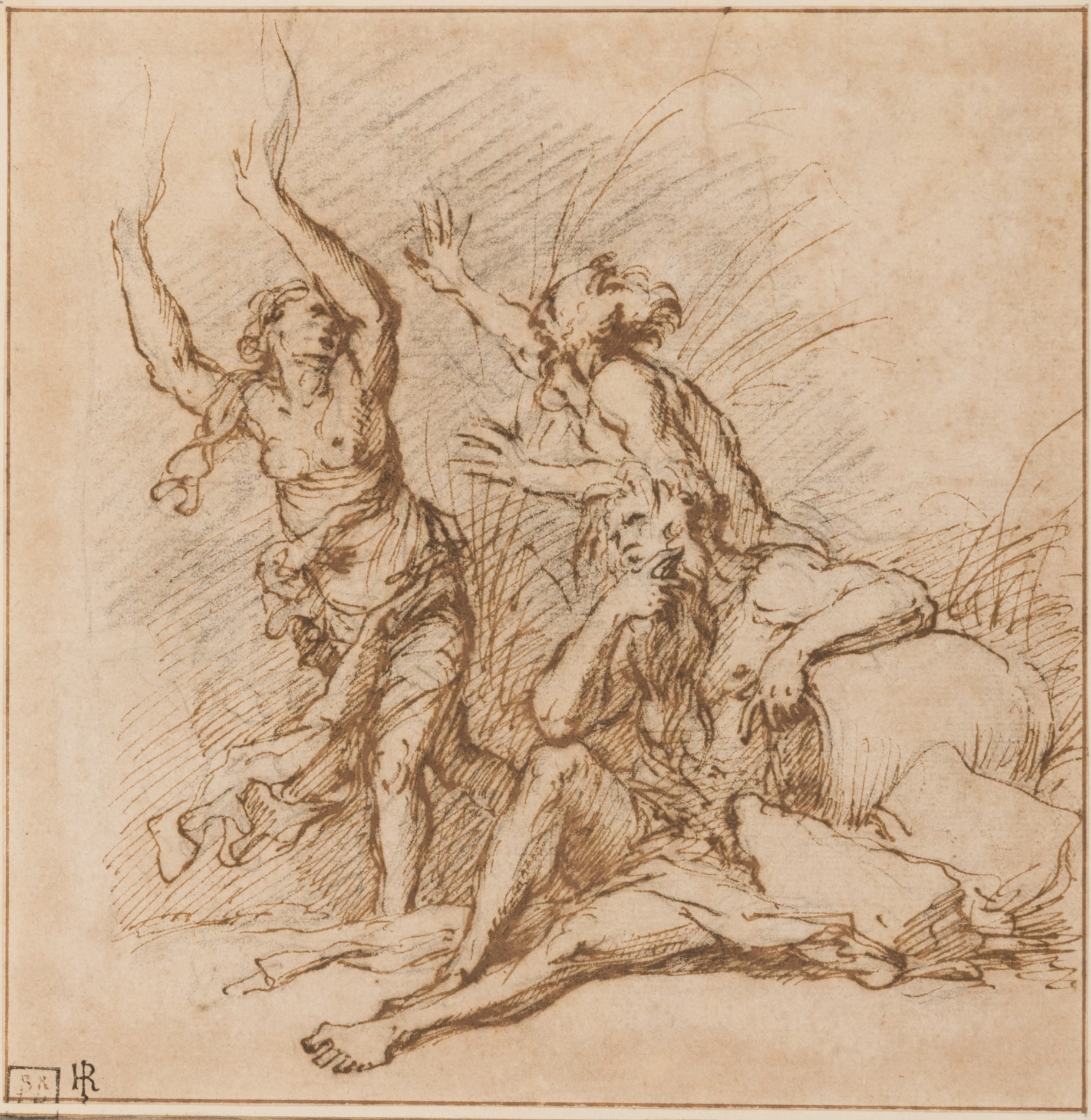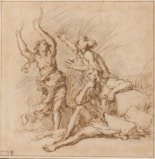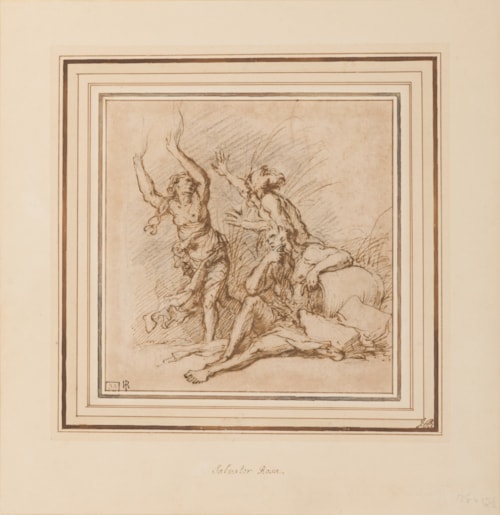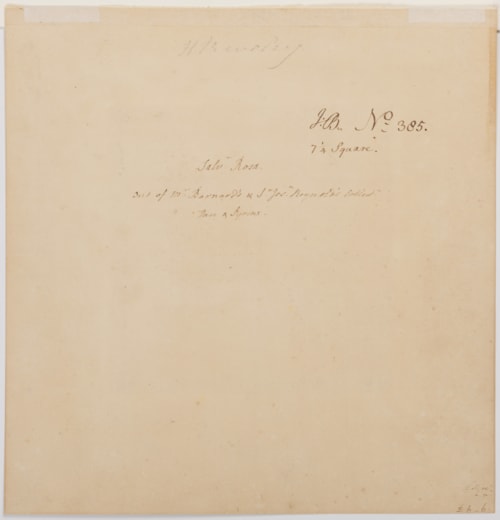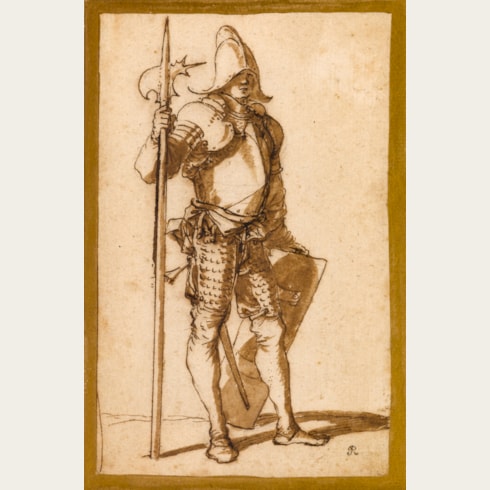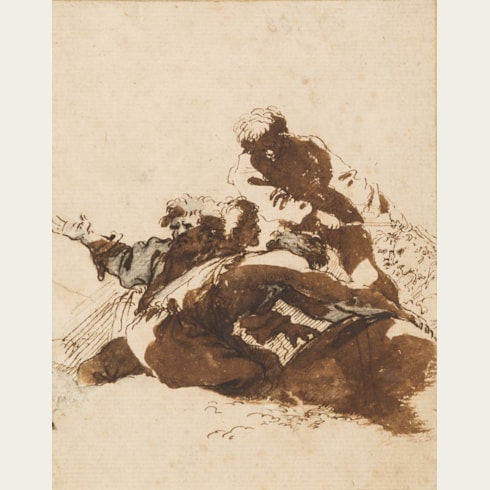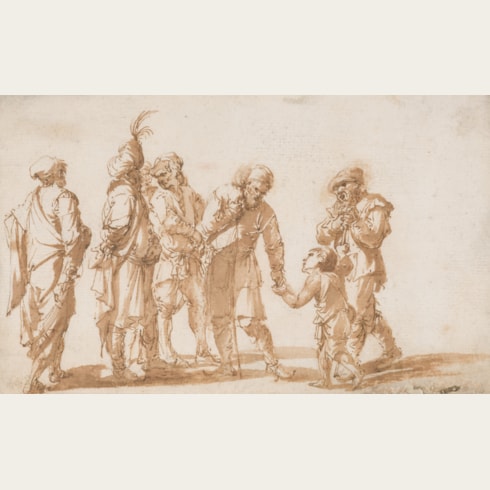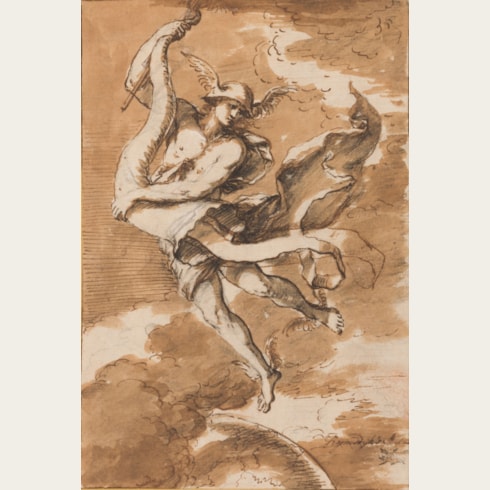Salvator ROSA
(Arenella 1615 - Rome 1673)
Pan and Syrinx
Sold
Pen and brown ink, and black chalk.
Laid down on an 18th century English mount, inscribed Salvator Rosa. in the lower margin.
Inscribed H. Reveley on the verso.
Further inscribed (by Barnard) J:B. No 385. / 7 1/4 Square. and (by Reveley) Salv: Rosa / out of Mr. Barnard’s & Sr. Jos.aReynold’s Collectn / Pan & Syrinx. on the reverse of the mount.
183 x 186 mm. (7 1/4 x 7 3/8 in.)
Laid down on an 18th century English mount, inscribed Salvator Rosa. in the lower margin.
Inscribed H. Reveley on the verso.
Further inscribed (by Barnard) J:B. No 385. / 7 1/4 Square. and (by Reveley) Salv: Rosa / out of Mr. Barnard’s & Sr. Jos.aReynold’s Collectn / Pan & Syrinx. on the reverse of the mount.
183 x 186 mm. (7 1/4 x 7 3/8 in.)
This drawing may be dated to Salvator Rosa’s Florentine period, between 1640 and 1649, and is an early preparatory study for a painting by the artist now in an Italian private collection in Caldaro, in the province of Bolzano. The painting appears to have been given as a presentor consigned to Rosa’s friend and sometime agent, the Florentine courtier, poet, collector and art dealer Francesco Cordini, who later sold it, along with other works by the artist, to the Austrian Archduke Ferdinand Karl of Tyrol for the sum of 800 scudi. (This transaction, undertaken without Rosa’s knowledge, caused a lasting rift between the artist and Cordini.) The subject is taken from Ovid’s Metamorphoses, and depicts the wood nymph Syrinx being pursued by the lusty satyr Pan. Reaching a river, here identified by the river god Ladon, Syrinx begged the river nymphs to save her, and was transformed into reeds just at the moment that Pan grasps her. (When Pan realized that he was holding nothing but reeds, he sighed in disappointment, causing the wind below through the reeds. Captivated by the sound they produced, which he believed to be the cry of Syrinx, Pan made a set of pipes from the reeds so that he could always hear her voice.) Rosa’s painting, which is horizontal in format and is mentioned in one of the artist’s letters of 1650, reflects something of the influence on him of the works of Nicolas Poussin that he would have seen in Rome.
The present sheet differs from the finished painting is depicting the river god at the lower right, rather than at the left, and placing a bit more space between the two main figures. The only other known preparatory drawing by Rosa for the Caldaro painting, a pen and ink sheet in the collection of the Princeton University Art Museum includes a study for the upper part of the figure of Syrinx, but shows her with her arms spread wide. A drawing of a seated river god in red and black chalk, in the Museum der bildenden Künste in Leipzig, has recently been posited as an early preparatory study for the river god at the lower left of the painted composition.
The present sheet was in the collections of three of the most significant English collectors of drawings of the 18th century. John Barnard (d.1784) usually signed the drawings he owned with his initials, as with the present example. Numbering around 1,100 sheets, Barnard’s collection of drawings and prints was dispersed at auction in 1787; as was noted in the preface to the sale catalogue, ‘a more capital collection was never offered to the Public or more worthy the Attention of the learned Connoisseurs’.
The drawing also bears the collector’s mark of the 18th century painter Sir Joshua Reynolds (1723-1792), the leading portrait painter in England. Reynolds’ fame and success allowed him to assemble one of the largest collections of paintings, drawings and prints of his day. His collection of several thousand drawings, for the most part consisting of Italian works of the 16th and 17th centuries, was sold at two auctions, organized by the artist, art dealer and print publisher Antonio Cesare di Poggi, in 1794 and 1798.
The present sheet was acquired by the British collector Henry Reveley (1737-1798), who was a great admirer of Barnard’s collection and had studied it at length. In his posthumously published Notices Illustrative of the Drawings and Sketches of some of the most Distinguished Masters in all the Principal Schools of Design, Reveley described Rosa’s drawings at length, and noted this sheet in particular: ‘The drawings of this incomparable artist are scarcely in less esteem than his paintings. Those that are most finished, which are very rare, are generally penned and washed with bistre; others, more slight, are penned only, in a loose style; while some, such as caricatures, are executed with red chalk…I have a few sketches by this master, which, though very slight, furnish striking indications of his powers; particularly a study for the Death of Polycrates; and a more finished Design of Pan and Syrinx…’
Reveley’s fine collection of drawings and prints was dispersed by his descendants many years after his death, at two auctions in London in 1852 and 1884.
The present sheet differs from the finished painting is depicting the river god at the lower right, rather than at the left, and placing a bit more space between the two main figures. The only other known preparatory drawing by Rosa for the Caldaro painting, a pen and ink sheet in the collection of the Princeton University Art Museum includes a study for the upper part of the figure of Syrinx, but shows her with her arms spread wide. A drawing of a seated river god in red and black chalk, in the Museum der bildenden Künste in Leipzig, has recently been posited as an early preparatory study for the river god at the lower left of the painted composition.
The present sheet was in the collections of three of the most significant English collectors of drawings of the 18th century. John Barnard (d.1784) usually signed the drawings he owned with his initials, as with the present example. Numbering around 1,100 sheets, Barnard’s collection of drawings and prints was dispersed at auction in 1787; as was noted in the preface to the sale catalogue, ‘a more capital collection was never offered to the Public or more worthy the Attention of the learned Connoisseurs’.
The drawing also bears the collector’s mark of the 18th century painter Sir Joshua Reynolds (1723-1792), the leading portrait painter in England. Reynolds’ fame and success allowed him to assemble one of the largest collections of paintings, drawings and prints of his day. His collection of several thousand drawings, for the most part consisting of Italian works of the 16th and 17th centuries, was sold at two auctions, organized by the artist, art dealer and print publisher Antonio Cesare di Poggi, in 1794 and 1798.
The present sheet was acquired by the British collector Henry Reveley (1737-1798), who was a great admirer of Barnard’s collection and had studied it at length. In his posthumously published Notices Illustrative of the Drawings and Sketches of some of the most Distinguished Masters in all the Principal Schools of Design, Reveley described Rosa’s drawings at length, and noted this sheet in particular: ‘The drawings of this incomparable artist are scarcely in less esteem than his paintings. Those that are most finished, which are very rare, are generally penned and washed with bistre; others, more slight, are penned only, in a loose style; while some, such as caricatures, are executed with red chalk…I have a few sketches by this master, which, though very slight, furnish striking indications of his powers; particularly a study for the Death of Polycrates; and a more finished Design of Pan and Syrinx…’
Reveley’s fine collection of drawings and prints was dispersed by his descendants many years after his death, at two auctions in London in 1852 and 1884.
A painter, draughtsman and printmaker, as well as an accomplished actor, musician and poet, Salvator Rosa studied in Naples with his brother-in-law Francesco Fracanzano, as well as probably with Jusepe de Ribera and Aniello Falcone, before making two trips to Rome in the second half of the 1630s. The following decade found him working in Florence, where among his patrons was Giovanni Carlo de’ Medici. It was in Florence that Rosa developed an interest in historical and mythological subjects, as well as in themes of witchcraft and the occult. An eccentric personality, he moved in literary and intellectual circles, which in turn inspired his idiosyncratic artistic vision. Returning to Rome in 1649, Rosa continued to paint unusual, often fantastical or macabre subjects alongside the paintings of battle scenes and wild landscapes with which he had first made a name for himself. In the late 1660s his compositions became darker and more oppressive. A gifted and prolific printmaker, Rosa produced over one hundred etchings, almost all of which were published and widely distributed in his lifetime.
Rosa was a remarkable draughtsman, and his spirited, exuberant drawings were highly praised by connoisseurs even in his own day. The bulk of the nine hundred or so surviving drawings by the artist are figure studies, usually in his preferred medium of pen and ink, and often enlivened with touches of wash. Many of the drawings from the early part of his career are signed, and these may have been sold to collectors or presented as gifts to friends or patrons. However, almost no signed drawings dating from after 1649 exist, and it has been suggested that, after his return to Rome, Rosa chose to keep most of his drawings for himself, and not part with them.
Rosa was a remarkable draughtsman, and his spirited, exuberant drawings were highly praised by connoisseurs even in his own day. The bulk of the nine hundred or so surviving drawings by the artist are figure studies, usually in his preferred medium of pen and ink, and often enlivened with touches of wash. Many of the drawings from the early part of his career are signed, and these may have been sold to collectors or presented as gifts to friends or patrons. However, almost no signed drawings dating from after 1649 exist, and it has been suggested that, after his return to Rome, Rosa chose to keep most of his drawings for himself, and not part with them.
Provenance
John Barnard, London (Lugt 1419), on his mount inscribed Salvator Rosa. and with his numbering (Lugt 1420) on the reverse
Probably his sale, London, Greenwood’s, 16-24 February 1787
Sir Joshua Reynolds, London (Lugt 2364)
By descent to his niece, Mary Palmer, later Marchioness of Thomond
The posthumous Reynolds sales, London, A. C. de Poggi, 26 May 1794 onwards or London, H. Philips, 5-26 March 1798
Henry Reveley, Bryn-y-Gwin, North Wales
Dr. Peter Mangold, Henley-on-Thames, Oxfordshire
His posthumous sale, Salisbury, Woolley & Wallis, 7 March 2018, lot 244 (as Attributed to Salvator Rosa)
Private collection
Anonymous sale, Salisbury, Woolley & Wallis, 11 September 2018, lot 54 (as Attributed to Salvator Rosa)
Private collection, New York.
Probably his sale, London, Greenwood’s, 16-24 February 1787
Sir Joshua Reynolds, London (Lugt 2364)
By descent to his niece, Mary Palmer, later Marchioness of Thomond
The posthumous Reynolds sales, London, A. C. de Poggi, 26 May 1794 onwards or London, H. Philips, 5-26 March 1798
Henry Reveley, Bryn-y-Gwin, North Wales
Dr. Peter Mangold, Henley-on-Thames, Oxfordshire
His posthumous sale, Salisbury, Woolley & Wallis, 7 March 2018, lot 244 (as Attributed to Salvator Rosa)
Private collection
Anonymous sale, Salisbury, Woolley & Wallis, 11 September 2018, lot 54 (as Attributed to Salvator Rosa)
Private collection, New York.
Literature
Henry Reveley, Notices Illustrative of the Drawings and Sketches of some of the most Distinguished Masters in all the Principal Schools of Design, London, 1820 [posthumously published], p.133; Phillip H. Delamotte and T. Frederick Hardwich, The Reveley Collection of Drawings at Brynygwin, North Wales, London, 1858, pl.35; Luigi Salerno, L’opera completa di Salvator Rosa, Milan, 1973, p.90, under no.84 (as lost); Michael Mahoney, The Drawings of Salvator Rosa, New York and London, 1977, Vol.I, pp.235-236, no.16.1; Vol.II, fig.16.1 (as whereabouts unknown, and dated to the mid-1640s); Caterina Volpi, Salvator Rosa (1615-1673) “pittore famoso”, Rome, 2014, p.472, under no.152; Alex Capon, ‘Watercolours worked up into saleroom success’, Antiques Trade Gazette, 7 April 2018.

